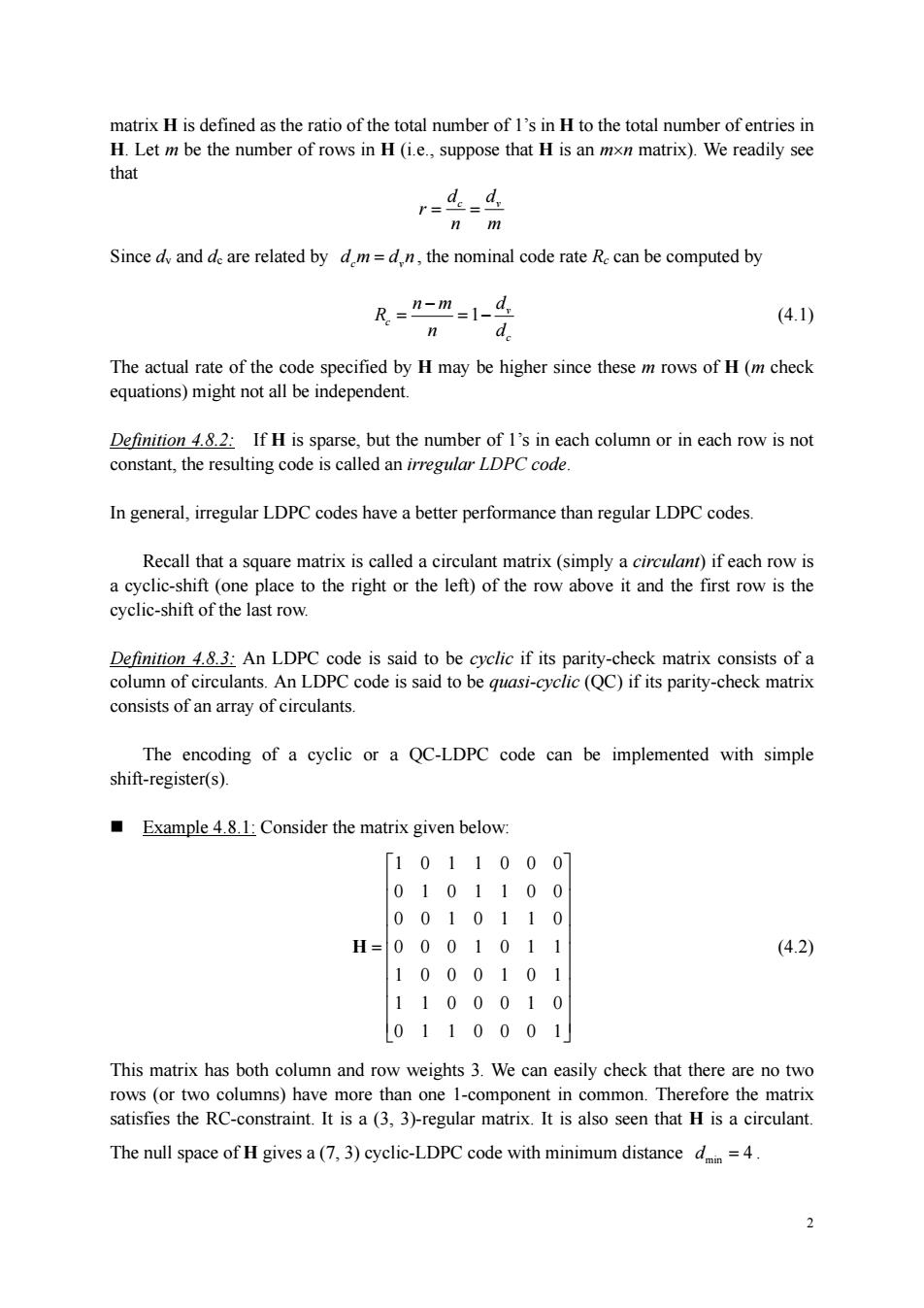正在加载图片...

matrix H is defined as the ratio of the total number of 1's in H to the total number of entries in H.Let m be the number of rows in H(i.e suppose that H is an mn matrix).We readily see that n m Since d and de are related by d.m=dn,the nominal code rate R can be computed by =1-4 (4.1) n d The actual rate of the code specified by H may be higher since these m rows of H(m check equations)might not all be independent. Definition48.2 If H is sparse,but the number of I's in each column or in each row is not constant,the resulting code is called an irregular LDPC code. In general,irregular LDPC codes have a better performance than regular LDPC codes. Recall that a squ rix is called a circulant matrix(simply a circulant)if each row is a cyclic-shift (one place to the right or the left)of the row above it and the first row is the cyclic-shift of the last row. Definition 483:An ldPC code is said to be cvclic if its parity-check matrix consists of a colum n of circulants.An LDPC code is said to be quasi-cyclic (QC)if its parity -check matrix consists of an array of circulants The encoding of a cyclic or a QC-LDPC code can be implemented with simple shift-register(s). Example 4.8.1:Consider the matrix given below: 「1011000 0101100 0110 H 1011 (4.2) 000101 1100010 0110001 This matrix has both column and r weights 3.We can easily check that rows (or two columns)have more than one 1-componen in common.Therefore the matri satisfies the RC-constraint.It is a (3.3)-regular matrix.It is also seen that H is a circulant The null space of H gives a(7,3)cyclic-LDPC code with minimum distanced=4. 2 matrix H is defined as the ratio of the total number of 1’s in H to the total number of entries in H. Let m be the number of rows in H (i.e., suppose that H is an m×n matrix). We readily see that c v d d r n m = = Since dv and dc are related by c v dm dn = , the nominal code rate Rc can be computed by 1 v c c n m d R n d − = = − (4.1) The actual rate of the code specified by H may be higher since these m rows of H (m check equations) might not all be independent. Definition 4.8.2: If H is sparse, but the number of 1’s in each column or in each row is not constant, the resulting code is called an irregular LDPC code. In general, irregular LDPC codes have a better performance than regular LDPC codes. Recall that a square matrix is called a circulant matrix (simply a circulant) if each row is a cyclic-shift (one place to the right or the left) of the row above it and the first row is the cyclic-shift of the last row. Definition 4.8.3: An LDPC code is said to be cyclic if its parity-check matrix consists of a column of circulants. An LDPC code is said to be quasi-cyclic (QC) if its parity-check matrix consists of an array of circulants. The encoding of a cyclic or a QC-LDPC code can be implemented with simple shift-register(s). Example 4.8.1: Consider the matrix given below: 1011000 0101100 0010110 0001011 1000101 1100010 0110001 ⎡ ⎤ ⎢ ⎥ ⎢ ⎥ ⎢ ⎥ ⎢ ⎥ = ⎢ ⎥ ⎢ ⎥ ⎢ ⎥ ⎢ ⎥ ⎢ ⎥ ⎣ ⎦ H (4.2) This matrix has both column and row weights 3. We can easily check that there are no two rows (or two columns) have more than one 1-component in common. Therefore the matrix satisfies the RC-constraint. It is a (3, 3)-regular matrix. It is also seen that H is a circulant. The null space of H gives a (7, 3) cyclic-LDPC code with minimum distance min d = 4